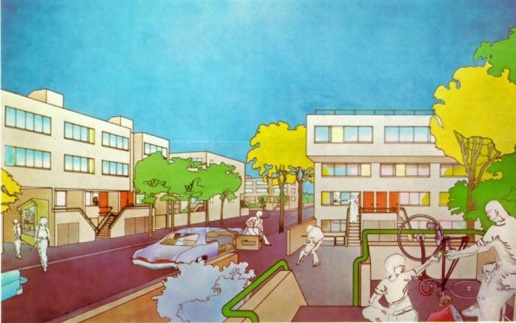Adapting the past to save cities

The latest buzz about public housing is that it fails, always, regardless of design. I've found evidence to the contrary.

With hundreds of strident comments by readers, an article the other day by Ginia Bellafante in The New York Times asked why Marcus Garvey Village has failed to improve life for its residents since it opened in 1976.
The public housing development in Brooklyn's Brownsville neighborhood, which features low-rise buildings with stoops and courtyards, was displayed as a new paradigm at the Museum of Modern Art just prior to opening in 1973. It seemed the perfect antidote to anonymous, high-rise housing that seemed to bring on crime: Give people privacy and more human-scaled homes, and they will thrive.
Failure of stoops and stairs?
The low-rise design did not bring the desired changes. Over time, the courtyards of Marcus Garvey Village became places for drug dealers to hide. The stoops inspired "more surveillance" rather than communality, Bellafante writes.
Low-rise failed the people. Or, perhaps, the people just failed, as much of the recent commentary claims.
Setting aside the classist and racist responses to Bellafante's article, it's clear that the focus has been on architectural layouts and elements -- the stoops and scissor stairs, for example -- and how they suit ideas held by social scientists and environmental psychologists.
But what about looks, feel and image? Marcus Garvey Village lacks any detail or ornament, which neighboring brownstones have in spades. It's a colorless, flat stack of blocks. The rendering shown at MoMA tried hard to look colorful and lively (at left, above), while the real thing stands as pure monotone, and a stab at pure modernism (at left, below).
Bellafante mentions the current exhibition at New York's Center for Architecture, called "Low Rise High Density," to trace the high hopes pinned to the low-rise approach to public housing. But that's just veering off course.
Ornament, color and detail?
Let's hear more about the visual image of Marcus Garvey Village, not its layout. The architectural look of the place seemed alien and unpleasant to many when it was built; the same goes today. It looks cheap and unfriendly, and not due to deterioration. It stands out against the classic Brooklyn brownstones as institutional, experimental and unabashedly modern.
I'll offer an alternative view. Visual identity is everything.
Visit Dorchester, Mass., where three decades of development have revitalized the Lower Mills area, a zone once seen as depressed, dangerous and unlivable. Today, there's activity on the streets, which feel safe. A few hipsters frequent the new cafes and shops that have opened in recent years.
At the center of this turnaround is a former industrial campus: Baker Chocolate Factory.
Overflowing with character
The classically detailed brick and masonry buildings, which date back to 1765, overflow with character. Arched windows and mansard roofs face the street.
In 1969, General Foods (now Kraft) moved production away to Delaware. The chocolate factory closed, and the local economy took a nosedive. Local leaders toyed with possible demolition of the complex.
A decade later, enter the late Bob Kuehn and his Keen Development Corp. -- a visionary for historic rehabilitation, affordable housing and community development.
Kuehn championed the mill's conversion to housing, though the three-phase project was painfully slow and incremental. It started exactly 30 years ago with the groundbreaking of phase one -- a profit-making venture with 143 mixed-income apartments opened to the public. (Disclosure: I consult to the conversion's architecture firm, The Architectural Team.)
Honored and effective
After its completion, President Ronald Reagan lauded the historic factory reuse, which earned the 1988 National Historic Preservation Award for the architects. Over the next few decades, Baker Chocolate Factory grew to encompass three phases of master planning and adaptive reuse to convert its centuries-old building and factory facilities into live/work artist lofts, affordable rentals, an assisted-living facility (ALF) and market-rate apartments developed by Beacon Communities and WinnDevelopment.
A large part of the success of Baker Chocolate is the deep connections that neighbors feel for the old buildings. Many had relatives who worked there; others are intrigued by its local legend as a home to another era's Willy Wonka. We must also give credit to its character: What it lacked in foresight as housing (in terms of layout and design, certainly) it amply makes up for with pure visual interest. People are attracted to these old bones -- these old wood windows and stone arches.
We'll need greenfield development for public housing, to be sure. But I hope this comparison yields at least a new way of considering the failures of Marcus Garvey Village. These housing blocks and nearby neighbors certainly have benefited from its conception as a human-scaled, well-ventilated complex. An apartment tower would have been no better. As the Center for Architecture states in its show description, "Forty years ago, low-rise, high-density housing offered a substitute for the high-rise model then dominating public housing in the United States."
But as this case study shows, that's not enough. Merely building low-rise fails to solve anything.
Our cities have lots of old buildings, city dwellers feel connected to them. Many cities also have historic tax credits and low-income housing credits that can induce private development. With a measure of public involvement, we can do even more.
The next time an old school or hospital is threatened with the wrecking ball, think about its value to the city and its people: The pure economics of lower-cost shelter, yes -- but also a reserve of beauty and memory that all can share.
This post was originally published on Smartplanet.com